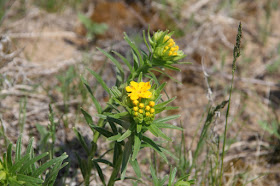Between being retired and following the COVID-19 safety measures, we've not been driving as much as in former years. That might account for our lack of turtle sightings this year. Or, perhaps the turtles egg-laying has been delayed? Anyway, we've missed the brief encounters this Spring that we've enjoyed most years by this time.
 |
| painted turtle crossing gravel road
Photo by J. Harrington
|
Hoary puccoon has started to come into flower. Several online sources mention Native American uses of this plant, but I've found no mention of it in Mary Siisip Geniusz Plants Have So Much to Give Us, All We Have to Do Is Ask | Anishinaabe Botanical Teachings.
 |
| hoary puccoon beginning to bloom
Photo by J. Harrington
|
Without much expectation of success, this morning I once again set traps for pocket gophers. There are fresh mounds in several widely separated locations on the back slope. If I could train gophers to eat buckthorn roots, I'd consider it a fair trade, but the gophers prefer the more open country of our fields where there are no buckthorns. As far as I know, gophers serve a very limited ecological role and have destroyed numerous fruit trees we've planted plus, they seem responsible for the disappearance of several prairie wildflowers we've planted, such as pasque flowers. Although the local deer have killed half of our chokeberry bushes, at least deer offer occasional aesthetic pleasures. Pocket gophers are ugly and out of sight underground most of the time.
Ellen Bass
GOPHERS
I’ve tried to kill the gophers. On stainedknees, up to my elbows in their earthentunnels, setting the green toothed trap, my humanscent masked with anise oil, then sweetenedwith leaves of the sweet potato vine my neighbor maintainsthey can’t resist, a rodent version of caviar and champagne.But the dead must do some arcanetransmission of wisdom to the living. They’ve eatenevery fleck of leaf, sprung each trap with cool disdain.They’re marvels, miniature Charlemagnes. Thensuddenly, I hear it—like a tiny microphone’s hiddenunder the dirt. You couldn’t mistake this blazonfor anything else, like Louis Armstrong singingIt’s a Wonderful World. But whenthe little fists of four leaf clover beginto tremble, I’m confused not to feel the thrill of the hunt, the cocainerush in my veins. I pick up the shovel—I’ve slainthem like this—a hose down the hole, then bash their brains,but my will wanes. It seems pointless to kill one denizenwhen there must be dozens taking the A-train,just trying to get to Sugar Hill. Listen.It’s not an Elizabeth Bishop fish thing.It’s not Galway’s bear or Stafford’s deer on the mountain,not Kunitz’s whale or Donald Hall’s paean,scratching the jowls of a cooked pig. I look into the grainyhole the gopher’s dug with his skinnyincisors, this corridor betweenworlds, and it’s the sound that stops me. That unseensmall tearing of the roots on such a serenemorning. I’m watching the grass shiver. I’m leaningover, straining to hear it again.
—from Rattle #34, Winter 2010
********************************************
Thanks for visiting. Come again when you can.
Please be kind to each other while you can.
No comments:
Post a Comment